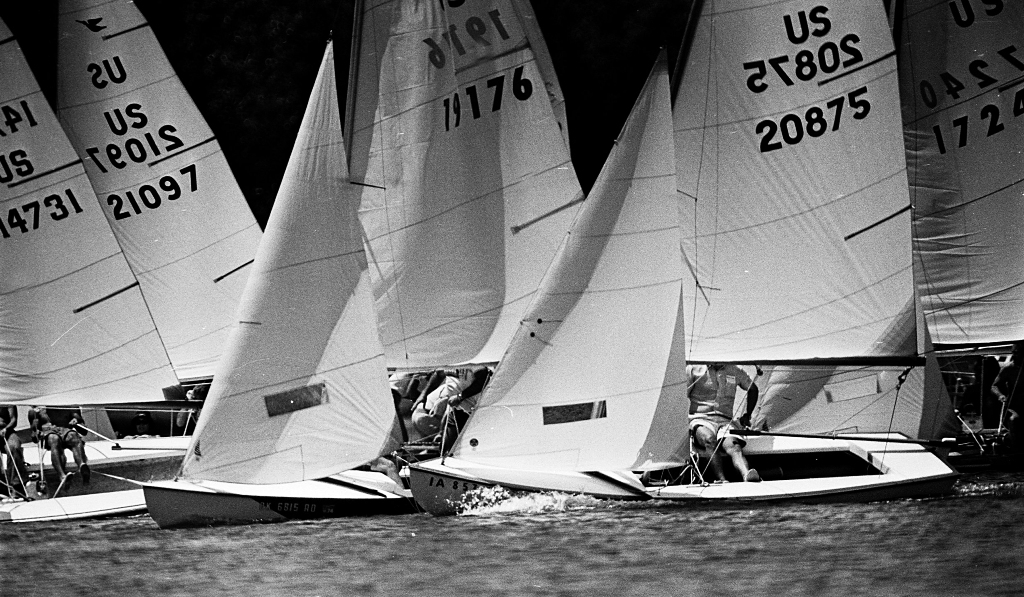
snipe regatta 74 start
Welcome to Shawnee Yacht Club
Since 1941, SYC has promoted sailing on Lake Shawnee for the recreational benefit of the local community. In addition to the opportunity to sail on beautiful Lake Shawnee, the club provides: free sailing lessons for those new to the sport, sailboats for members to use, a fenced boatyard with a boat ramp, several docks (provided by Parks and Rec), a storage shed for equipment, sailing activities, racing, and social gatherings.
Topeka, Forbes Field
38°F - Fair
Wind
Vrbl 3 mph
Humidity
60%
At
07:53 PM
Coming Events
SYC on Facebook
Mark's Racing Blog
Mark's MC Tuning Theory
Entering my third year of sailing the MC, I think I've deciphered how you are supposed to tune it up. I reserve the right to change my mind without notice. Here goes.
Low wind. That is not enough wind to bend the mast. The straight mast makes the sail have too much curve at the luff (you can't point) and too tight a leach (cupping to windward choking the boat). Here is how I try to overcome these defects. Slightly over tighten the outhaul to open the lower leach, and move the traveler out so the boom is on the aft corner. These adjustments will make the leach parallel to the centerline of the boat.
Medium wind. Any wind that lets the sail assume its designed shape. The mast will bend, and we can trim all the sail controls too much or too little. Here is what I do. Pull the outhaul and downhaul until there are no wrinkles coming of the spars. Trim the traveler and main sheet to make the leach parallel to the boat centerline. Too lose and you are not using all the power, too tight and you are choking the sail. You will be continually adjusting the leach tension with the main sheet.
Heavy wind. You are over powered. Now you are on the rail and having trouble keeping the angle of heel to less than 20 degrees. The sail has more wind than the boat can use. Reduce power by over stretching the controls. Outhaul to open the lower leach. Downhaul to open the upper leach. Vang to over bend the mast, flattening the lower front part of the sail. Ease the main sheet to twist off the top of the sail (controlling the angle of heel). The main sheet is now your primary control of the angle of heel.
In all conditions. Align the sail to the wind. (Your indication is the sail tell tails.)
Maintain 15-20 degrees of heel. (Leeward board should be nearly vertical.)
Balance the helm by raising/lowering the boards. (The indicator is the tiller position.)
Ease/Hike/Sheet in the puffs. Even little ones. (Accelerate the boat, don't point.)
Low wind. That is not enough wind to bend the mast. The straight mast makes the sail have too much curve at the luff (you can't point) and too tight a leach (cupping to windward choking the boat). Here is how I try to overcome these defects. Slightly over tighten the outhaul to open the lower leach, and move the traveler out so the boom is on the aft corner. These adjustments will make the leach parallel to the centerline of the boat.
Medium wind. Any wind that lets the sail assume its designed shape. The mast will bend, and we can trim all the sail controls too much or too little. Here is what I do. Pull the outhaul and downhaul until there are no wrinkles coming of the spars. Trim the traveler and main sheet to make the leach parallel to the boat centerline. Too lose and you are not using all the power, too tight and you are choking the sail. You will be continually adjusting the leach tension with the main sheet.
Heavy wind. You are over powered. Now you are on the rail and having trouble keeping the angle of heel to less than 20 degrees. The sail has more wind than the boat can use. Reduce power by over stretching the controls. Outhaul to open the lower leach. Downhaul to open the upper leach. Vang to over bend the mast, flattening the lower front part of the sail. Ease the main sheet to twist off the top of the sail (controlling the angle of heel). The main sheet is now your primary control of the angle of heel.
In all conditions. Align the sail to the wind. (Your indication is the sail tell tails.)
Maintain 15-20 degrees of heel. (Leeward board should be nearly vertical.)
Balance the helm by raising/lowering the boards. (The indicator is the tiller position.)
Ease/Hike/Sheet in the puffs. Even little ones. (Accelerate the boat, don't point.)